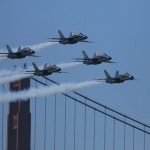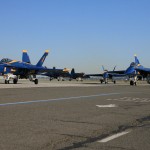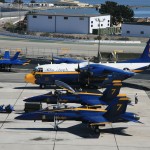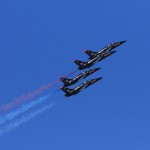By Brian K. Roat
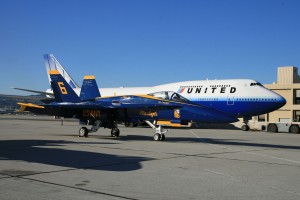
A United Airlines 747 dwarfs Blue Angel number 6 at the maintenance facility housing the Blue Angels team, miles away from show center.
The legendary rock band Journey got their start in San Francisco; their famous song, “Lights,” celebrated a love for the City by the Bay. But another love was stirred from October 4-9, when the Bay Area hosted the annual Fleet Week, an event honoring the men and women serving in the U.S. Navy, Coast Guard and Marine Corps, and celebrating the city’s rich naval history.
Fleet Week is one of only a few air show events where the U.S. Navy Blue Angels perform away from the airport where flight operations take place. Flight operations are staged at the United Airlines maintenance facilities on the east side of San Francisco International Airport (SFO). Each year, United hosts the Blue Angels, and a very limited number of special guests get to witness the ground performance that the rest of the crowds miss.
Even though the sky-watching crowds were miles away at show center along historic Fisherman’s Wharf, the Blue Angels maintained their precision throughout their entire performance—from marching along the flight line to their respective aircraft, to climbing in the cockpit, starting their jet engines and the first synchronized puff of smoke. Being a precision jet demonstration team means they demonstrate their excellence on the ground as well as in the air. Though not many can see it, they pull out and taxi in pairs as they would in front of a crowd of 100,000.
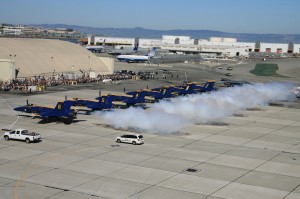
The Blue Angels show begins on the ground, demonstrating precision while marching to the planes, getting in the cockpits starting the engines, and maintaining a synchronized puff of smoke during takeoff, even though the air show crowds are miles away.
After the flight leader called “Ready, burners on, smoke on, brakes off,” the diamond formation (Blue Angels 1 through 4) rolled down the runway as the magnificent F/A-18 Hornets prepared to take to the air. “Ready, wheels up,” and the slot plane pulled up to complete the takeoff maneuver—even though the only people to see were the air traffic controllers in the tower. Then, it’s off to the show.
Part of the magnificence of Fleet Week comes from the Bay Area landmarks themselves. In addition to the beautiful San Francisco skyline, a Fleet Week photo set just isn’t complete without the Golden Gate Bridge and Alcatraz in the background. After the Blue Angels wowed the crowds with their stunning performances of solo and team formation flying, they headed back to SFO to restage. Again, even though the show was over and the crowds weren’t around to see it, they taxied back with the same precision with which they awed the spectators.
If you’ve ever been to a Blue Angels air show, or any pre-show events, you might have seen a two-seat F/A-18 Hornet, number 7, sitting away from the precisely lined-up numbers 1 through 6. Number 7 usually arrives before the rest of the team so the pilot can help coordinate last-minute logistics and occasionally take select members of the media or special guests on a thrilling ride. Number 7 also serves as a backup plane, in case a mechanical problem grounds one of the primary jets from flying with the team. Two number 7s are actually on the tarmac, as well as an additional un-numbered jet that can be quickly re-numbered so the team never misses a beat. The show must go on—and the crowds love them for it.
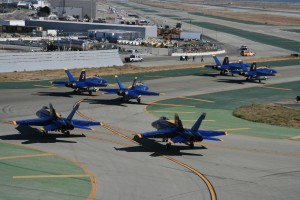
Though few ever see this part of the Blue Angels precision demonstration, the team still taxis out for takeoff in formation.
This year the Blue Angels celebrated 20 years of flying the F/A-18 Hornet at air shows around the U.S. Demonstrating and role modeling the team’s core values of honor, courage and commitment lies at the heart of an unwavering drive in their pursuit of excellence. In 2006, the Blue Angels performed before more than 15 million spectators. Since their inception in 1946, the team has performed for more than 427 million fans.
Many other special flight demonstrations took to the sky. Continuing with the military theme, a pair of Marine Corps Cobra gunships accompanied a pair of Marine Corps Huey assault helicopters. The Air Force sent their Heritage Flight: a World War II-era P-51 Mustang flying in formation with a modern F-16 Fighting Falcon. This USAF flying duo is a tribute to the people and machines that have served and defended our country over many decades.
Civilian aviation was present with an exciting demonstration by the Patriots Jet Team—a local air show demonstration from northern California. The Patriots fly four two-seat Czechoslovakian L-39 Albatros jets, modified for air show performances with improved engines, lighter weight and modern avionics. Their stunning diamond formation flying and synchronized red, white and blue smoke thrills crowds. Dean “Wilbur” Wright leads the team. Flying right wingman is Volodymyr “MiG” Chetverous, left wingman is John “Boards” Posson, slot is Paul “Sticky” Strickland and number 5 is the announcer and media pilot, Jon “Jughead” Counsell.
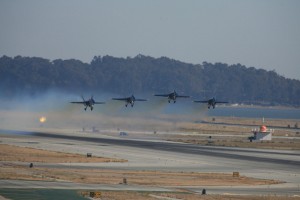
Even though the crowds don’t see takeoff, the Blue Angels team launches with precision as *though millions were watching.
A new flight demonstration making its appearance on the air show circuit this year is the Collaborators Formation Aerobatic Team. Veteran air show master Sean D. Tucker founded and leads the team. His son, Eric Tucker, flies as his left wingman, Ben Freelove as right wingman and Bill Stein flies the slot. The team is from King City, Calif., on U.S. Highway 101 south of Santa Cruz—another great example of the amazing aviation talent we have here in Northern California.
The biggest surprise of Fleet Week was a flyby of the world’s largest passenger aircraft, running through its certification gauntlet and a worldwide promotional tour. The European double-decker Airbus A380 had arrived at SFO earlier in the week for its Bay Area showcase to the commercial airline community and media outlets. It was a jaw-dropping sight for everyone in the crowd to lay their eyes on this mammoth in the sky for the first time.
From an F/A-18 Hornet flying near the sound barrier to a lumbering A380 giant in the sky, from the awe-inspiring Blue Angels to the local northern California Patriots jet demonstration team, and everything in between, Fleet Week 2007 was a great success and definite crowd pleaser.
For more information about Fleet Week, visit [http://www.fleetweek.us/fleetweek].
- The U.S. Navy Blue Angels race by the Golden Gate Bridge, heading toward show center at Fisherman’s Wharf in downtown San Francisco.
- A Blue Angels show isn’t complete without the thunderous approach of the beloved “Fat Albert” C-130 support plane, flown by the U.S. Marine Corps. Crowds gather along the pathways of Alcatraz Island for a great view of the air show.
- After the performance, the Blue Angels taxi back with the same precision demonstrated during the air show.
- At each event in which the Blue Angels perform, a number 7 jet arrives early for media and pre-show buildup. Shown are two number 7s and a third Hornet, on the far side of “Fat Albert.” The Blue Angels can quickly renumber these extra jets.
- The biggest surprise during Fleet Week was a flyby of the European Airbus A380, the world’s largest passenger airplane.
- Sean D. Tucker founded the Collaborators Formation Aerobatic Team, based in Northern California, with his son Eric Tucker, who is left wingman. Ben Freelove flies the right wingman position and Bill Stein flies slot.
- A local air show demonstration from Northern California, the Patriots Jet Team flies four two-seat Czechoslovakian L-39 Albatros jets, modified for air show performances with improved engines, lighter weight and modern avionics.
- The U.S. Air Force Heritage Flight graced the skies at Fleet Week with a WWII-era P-51 Mustang and a modern F-16 Fighting Falcon in a flying tribute to the people and machines that have served our country for many decades.












